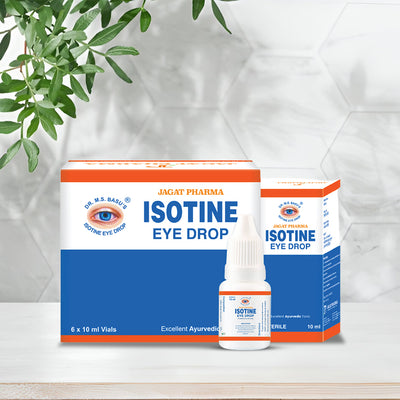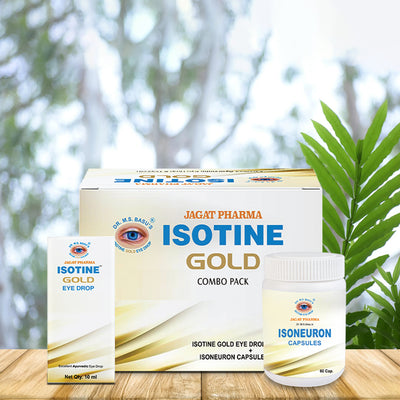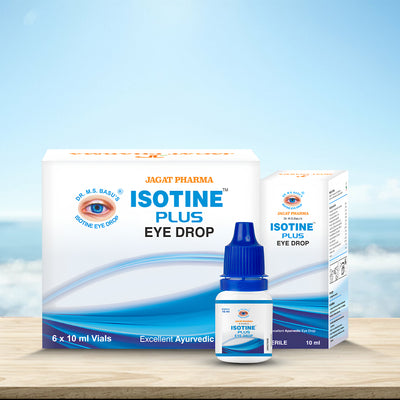
Eye Allergies & Its Reasons
The human eye is finely tuned to perceive light and translate it into visual information. However, this sensitivity also makes the eyes susceptible to seasonal allergies, particularly allergic conjunctivitis. This is how we look for eye drops for allergies during certain times of the year, such as spring and summer. Airborne allergens like pollen from grasses, trees, and weeds have the potential to affect an immune response in the eyes.
Symptoms of seasonal eye allergies include itching, redness, swelling, tearing, and a gritty sensation.
These allergens can also exacerbate conditions like dry eye syndrome, making the eyes feel dry and uncomfortable. Managing seasonal eye allergies involves avoiding allergens when possible, using Isotine Eye Drops to relieve symptoms, and maintaining good eye hygiene. Consulting with an eye specialist can help identify specific triggers and develop an effective treatment plan to minimize discomfort and preserve eye health during allergy seasons.
Structure of Human Eye
- Cornea: The transparent, dome-shaped surface that covers the front of the eye. It helps to focus light into the eye.
- Pupil: The black circular opening in the center of the iris that regulates the amount of light entering the eye.
- Iris: The colored part of the eye surrounding the pupil. It controls the size of the pupil and thereby the amount of light that enters the eye.
- Lens: Located behind the iris and pupil, the lens focuses light onto the retina. It changes shape to adjust focus, allowing us to see objects at various distances (accommodation).
- Retina: Located at the rear of the eye, the innermost layer houses millions of light-sensitive cells known as rods and cones. These cells are crucial in converting light into electrical signals, which are then transmitted to the brain through the optic nerve.
- Optic Nerve: Transmits visual information from the retina to the brain.
- Vitreous Humor: A clear, gel-like substance that fills the space between the lens and the retina, helping to maintain the shape of the eye.
- Sclera: The tough, white outer layer of the eyeball, often called the "white of the eye." It provides structure and protection.
- Choroid: A layer of blood vessels between the sclera and the retina that supplies oxygen and nutrients to the retina.
- Ciliary Body: Produces aqueous humor (fluid) that maintains the shape of the eye and nourishes the cornea & lens.
- Aqueous Humor: A clear fluid that fills the space between the lens & the cornea, providing nourishment and maintaining intraocular pressure.
- Conjunctiva: A thin, transparent membrane covering the front of the eye (except the cornea) and the inner surface of the eyelids. It helps lubricate and protect the eye.
This structural organization allows the eye to capture and process visual information, enabling us to see the world around us. Each part plays a crucial role in the complex process of vision.
What Makes Eyes Sensitive to Allergies?
Allergen Exposure: Allergens like pollen, dust mites, pet dander, mold spores, and certain chemicals can enter the eyes and trigger an immune response.
Histamine Release: When allergens contact the eyes, they can trigger mast cells in the conjunctiva (the transparent and thin membrane covering the white part of the eye and inner eyelids) to release histamine and other chemicals.
Inflammatory Response: Histamine and other chemicals cause inflammation in the tissues of the eyes. This inflammation leads to symptoms such as itching, redness, swelling (edema), tearing (excessive tearing or watery eyes), and irritation.
Conjunctival Reaction: The conjunctiva becomes swollen and irritated, resulting in a condition known as allergic conjunctivitis.
Eye Sensitivity: The eyes may become more sensitive to light (photophobia) during an allergic reaction due to the inflammation and increased tear production.
Duration of Exposure: Prolonged exposure to allergens can exacerbate symptoms and increase eye sensitivity over time.
Individual Susceptibility: Some individuals are more prone to eye allergies due to genetic predisposition or underlying conditions such as asthma or eczema, which are often associated with allergic reactions.
What is Allergic Conjunctivitis?
Allergic conjunctivitis occurs when the conjunctiva, a thin, transparent tissue layer covering the white part of the eye and lining the inside of the eyelids, becomes inflamed in response to an allergic reaction. It is a common type of eye allergy and can cause significant discomfort, but it is not contagious.
Causes: Allergic conjunctivitis is triggered when the eyes come into contact with allergens that the immune system recognizes as harmful. Common allergens include pollen, dust mites, pet dander, mold spores, and certain chemicals.
Symptoms: The typical symptoms of allergic conjunctivitis include:
- Itching sensation in the eyes.
- Redness of the eyes.
- Watery eyes (excessive tearing).
- Swelling of the conjunctiva.
- Sensitivity to light (photophobia).
- Blurred vision due to excessive tearing and eye discomfort.
Isotine Eye Drops for Allergies
Isotine Eye Drops are specifically designed to provide robust support for maintaining optimal eye health, which is particularly beneficial during the summer months when eyes are more susceptible to allergens and environmental irritants. These drops are formulated to effectively address common issues associated with summer allergies, such as dryness, irritation, and heightened sensitivity to UV rays.
The scorching sun and increased outdoor activities can exacerbate these symptoms, leading to discomfort and redness in the eyes. Isotine Eye Drops offer a valuable solution by instantly hydrating and lubricating the eyes, thereby alleviating irritation caused by exposure to allergens and other environmental factors.
Moreover, Isotine Eye Drops are enriched with natural extracts and antioxidants known for their ability to promote overall eye health. These ingredients nourish and protect the delicate structures of the eyes, helping to maintain clear and comfortable vision. By incorporating Isotine Eye Drops into your summer eye care routine, you can effectively safeguard your eyes against the harsh effects of seasonal allergies. This ensures that you can enjoy a summer filled with outdoor activities and relaxation, while keeping your eyes healthy and comfortable.
Conclusion
Understanding the complexities of the human eye and its susceptibility to seasonal allergies underscores the importance of proactive eye care. The eye's intricate structure, designed for optimal vision, also makes it vulnerable to allergens like pollen, dust, and pet dander. Allergic conjunctivitis, characterized by itching, redness, and sensitivity to light, can significantly impact daily comfort and visual clarity, especially during spring and summer months.
Isotine Eye Drops emerge as a reliable ally in combating these challenges, offering immediate relief from symptoms such as dryness and irritation. Their formulation, enriched with natural extracts and antioxidants, not only soothes but also nourishes the eyes, promoting long-term health.


